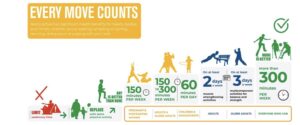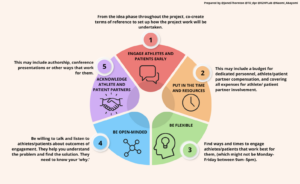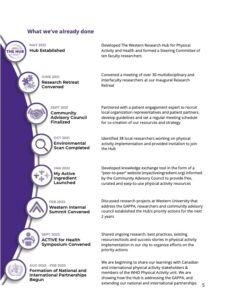April 6th is World Physical Activity Day. Established in 2002 by Agita Mundo with support from the World Health Organization (WHO), it is a perfect opportunity to reflect on where we are around the world and highlight bright spots for improvement. Here we present a Canadian example of answering the WHO’s call to action on physical activity implementation.
Infographic 1: Every move counts

The Problem – Our Collective Physical Inactivity
Physical activity benefits health in many ways at any age, playing a vital role in treatment and prevention of noncommunicable diseases, but we aren’t moving nearly enough:
- Half (49%) of Canadian adults (18–79 years) and fewer than half (44%) of children and youth (5–17 years) meet national physical activity guidelines for their health (1).
- Worldwide, it is estimated that physical inactivity causes 6% of the burden of disease from coronary heart disease, 7% of type 2 diabetes, 10% of breast cancers and 10% of colon cancers (2). Physical inactivity is also associated with a higher risk of severe COVID-19 outcomes (3,4) and a higher likelihood of infection (5).
- Our collective inactivity is one of the largest risk factors for early morbidity and mortality. A 25% reduction in the rate of physical inactivity would prevent an estimated 1.3 million deaths a year globally (2).
Infographic 2: Physical Activity Prevalence in 2020

World Health Organization’s Global Action Plan on Physical Activity
The World Health Organization (WHO) launched the Global Action Plan on Physical Activity (GAPPA) in 2018 to deal with this global epidemic, helping countries prioritize decreasing physical inactivity. The WHO’s target is to reduce the global prevalence of physical inactivity in adults and adolescents by 15% by 2030. The WHO released updated global physical activity guidelines to help countries implement the GAPPA.
Implementation includes strategies to promote the adoption and integration of evidence-based health interventions into practice. Implementation research includes, but is not limited to, examining factors affecting implementation, implementation processes, methodologies and outcomes. The intent is to understand what, why and how interventions work in “real world” settings.
The Project – Western Research Hub for Physical Activity and Health
The Western Research Hub for Physical Activity and Health is our response to this call to action. Our mission is: to advocate for and implement meaningful, sustainable and culturally relevant physical activity opportunities within our community and beyond.
Our established team of over 30 diverse junior and senior scholars from seven different Faculties at Western University in London, Ontario, Canada, and a Community Advisory Council of members made up of six local organization representatives and four patient partners who co-design and inform our work. As Director of the Hub, I work closely with our Community Advisory Council (CAC) and research team, developing and implementing physical activity research accountable to our mission.
“Nothing about us, without us”: the importance of a Community Advisory Council
Our CAC addresses the GAPPA’s call for a “whole of system” response, including multisectoral partnerships and meaningful community engagement to tackle the physical inactivity epidemic. We selected CAC members through an interview process, seeking to identify and recruit diverse perspectives from individuals with lived experience, members of under-represented groups, and community organisation representatives. The CAC meets regularly with our research team, bringing important and varied perspectives to co-design our implementation strategy using an integrated approach.
Reflections from CAC members indicate key motivating factors for participation:
- being part of research team, shaping research questions, contributing to the decision-making process
- giving feedback from their unique perspectives
- flexible meeting times and a direct line of communication with researchers making participation easier
- feeling valued through honoraria
These factors are summarized in our Patient Engagement Model (Figure 1), a direct result of our work with the CAC.
Figure 1: Patient engagement model

Building Capacity for Implementation
Over the next 2 years, the Hub will address 8 priorities as identified and voted on by our community (Figure 2):
Figure 2: Community-led priorities for physical activity implementation
(1) engage and establish partnerships with key stakeholders
(2) harmonize messaging about physical activity among healthcare providers
(3) explore post-pandemic opportunities to support mental health of children
(4) address infrastructural barriers to physical activity
(5) invest and promote active travel to schools and workplaces
(6) explore the use of technologies & digital tools to promote physical activity equitably
(7) support social connectedness and mental health of older adults through physical activity programming in community and institutional settings
(8) ensure that individuals receiving institutional care can access equipment and resources to support movement and physical activity
Our Implementation Support Service pilot will provide access to tools and resources for interested researchers and community members to build capacity, strengthen partnerships and increase potential for successful implementation projects. We will act as a centralized access point with a free knowledge mobilization platform, seed grants to help fund these projects, and a website to signpost these resources to the public.
Conclusion
By tracking and highlighting our own process for co-creating opportunities for physical activity implementation with patient partners and stakeholders, we hope the Western Research Hub can foster even more opportunities for capacity building, knowledge exchange, participatory research and cross-collaboration globally, Within Canada, our innovative and interdisciplinary Research Hub will provide resources and facilitate access to physical activity, resulting in more Canadians staying active for more of their lives, with implications for population-level health.
Infographic 3: What we’ve already done

Further information
Other links: Twitter/Instagram @MyActivIngrednt, @JaneSThornton, @R2HPLab
Direct link to pdf: http://returntohealthandperformance.org/wp-content/uploads/2023/04/Western-Research-Hub-white-paper-FINAL.pdf
To read more about this project in general visit: https://returntohealthandperformance.org/projects
Website: www.returntohealthandperformance.org, www.myactiveingredient.org (under construction)
Author of blog: Jane Thornton MD PhD CCFP(SEM)
Acknowledgments:
Dr. Rory Vaughan, Dr. Kristen Reilly, Dr. Becky Breau, our Community Advisory Council and funding support from Western University and the Canadian Institutes of Health Research.
References:
- Statistics Canada. Canadian Health Measures Survey: Activity monitor data, 2018-2019 [Internet]. 2021. Available from: https://www150.statcan.gc.ca/n1/daily-quotidien/210901/dq210901c-eng.htm
- Lee IM, Shiroma EJ, Lobelo F, Puska P, Blair SN, Katzmarzyk PT. Effect of physical inactivity on major non-communicable diseases worldwide: an analysis of burden of disease and life expectancy. The Lancet. 2012 Jul;380(9838):219–29.
- Sallis R, Young DR, Tartof SY, Sallis JF, Sall J, Li Q, et al. Physical inactivity is associated with a higher risk for severe COVID-19 outcomes: a study in 48 440 adult patients. Br J Sports Med. 2021 Oct;55(19):1099–105.
- Steenkamp L, Saggers RT, Bandini R, Stranges S, Choi YH, Thornton JS, et al. Small steps, strong shield: directly measured, moderate physical activity in 65 361 adults is associated with significant protective effects from severe COVID-19 outcomes. Br J Sports Med. 2022 Feb 9;bjsports-2021-105159.
- Lee SW, Lee J, Moon SY, Jin HY, Yang JM, Ogino S, et al. Physical activity and the risk of SARS-CoV-2 infection, severe COVID-19 illness and COVID-19 related mortality in South Korea: a nationwide cohort study. Br J Sports Med. 2021 Jul 22;bjsports-2021-104203
